Filtered By: Scitech
SciTech
Circus science: Putting big ideas under the big top
By Shaira Panela, GMA News
Ladies and gentlemen, your attention please!
There was a one-day only circus in town, complete with gypsies, ballerinas, mimes, magicians and clowns.
Only, instead of elephants balancing on balls, juggling monkeys on cables, and lions jumping through rings, this circus has science experiments. 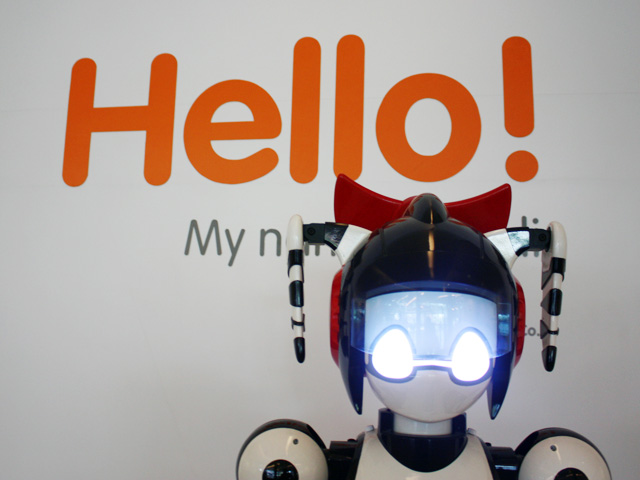 The experiment circus showcased different physics-related problems and solved them using the easiest way possible: fun and play. From the wonders of a glass-bottle xylophone and exploding soda cans to creating your own slime and a fire tornado, it's a feast on the eyes —and food for the brain.
The experiment circus showcased different physics-related problems and solved them using the easiest way possible: fun and play. From the wonders of a glass-bottle xylophone and exploding soda cans to creating your own slime and a fire tornado, it's a feast on the eyes —and food for the brain.
 The experiment circus showcased different physics-related problems and solved them using the easiest way possible: fun and play. From the wonders of a glass-bottle xylophone and exploding soda cans to creating your own slime and a fire tornado, it's a feast on the eyes —and food for the brain.
The experiment circus showcased different physics-related problems and solved them using the easiest way possible: fun and play. From the wonders of a glass-bottle xylophone and exploding soda cans to creating your own slime and a fire tornado, it's a feast on the eyes —and food for the brain. The Mind Movers of the Mind Museum, an interactive science museum in Taguig City staged the experiment circus on Aug. 26, Sunday as part of their theme for the month of August, Physics.
Physics is a branch of natural science that deals with matter and its motion through space and time.
Currently, it is being taught in 4th year high school as a separate subject but what the Mind Museum did was presented its concepts in a simpler way for the younger audience of the museum.
Engaging kids and parents
Mind Mover Garrick Bercero said this is one of their ways to engage the younger generations to take interest in science, and they have been receiving good feedback.
"From what we've seen, when guests come in, the kids kinda have an amusement park mentality. They want to be entertained. But, after they have seen the exhibits, they ask all sorts of questions and it's really encouraging..." said Bercero.
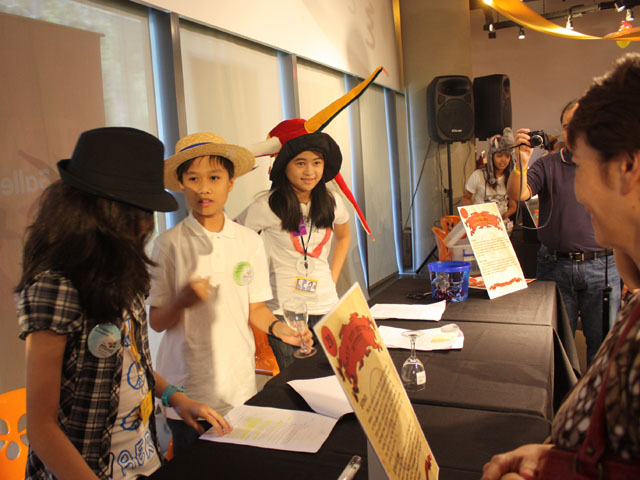 Physicist Maricor Soriano, who spoke about light and color before the circus started, said in an interview with GMA News Online, "[K]ids are natural scientists, noh, their first question is why... [they] are typically curious, so we have to nurture that."
Physicist Maricor Soriano, who spoke about light and color before the circus started, said in an interview with GMA News Online, "[K]ids are natural scientists, noh, their first question is why... [they] are typically curious, so we have to nurture that." The experiment circus, together with the other exhibits at The Mind Museum, is one of the ways that Bercero said could encourage kids to love science.
"Seeing people engaged in what people see traditionally as boring, dull, detached, that's really... I mean... I don't think that has been an angle approach here in the philippines," said Bercero.
The need for a Filipino scientific mindset
Bercero even said that the Philippines still has to develop a scientific mindset like that of the other countries.
"Science in its nature is actually worldclass e. There's no Philippine science, there's no American science... it has to be objective. Even though it is entertaining, we do no want to sacrifice the science," added Bercero.
Meanwhile, Soriano said that even the science education, particularly physics, in the Philippines suffer from a lack of interest not just from students but also from parents as well. This makes it necessary for initiatives like that of the experiment circus.
"These activities actually can run up interest into physics. Kasi kulang na kulang ang pumapasok sa physics, unlike engineering, unlike nursing.. andami-dami, over-over na sa nursing," said Soriano.
The state of science education in the PHL
For many Filipino parents and children, there is little motivation to venture into careers in science and engineering.
From the academic years 1994-1995 until 2010-2011, the average number of enrollees for engineering, information technology and natural sciences accounted for almost one-fourth (24%) or 573,569 of the total average enrollees (2,405,585) annually. Much lesser is the average number of graduates from these disciplines at 14.14 percent or 79,207 graduates annually. 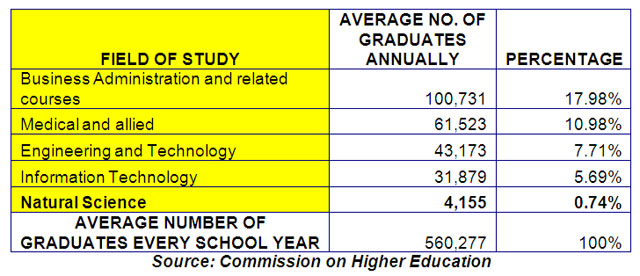

The highest number coming from business-related courses, and medical courses such as nursing and physical therapy—or those which have assumed higher demand abroad.
Commission on Higher Education chairperson Patricia Licuanan said in an earlier interview with GMA News that there is an oversubscription in business, teaching education, nursing, hotel and restaurant management, maritime, and information technology courses. She also mentioned that the commission had already issued a moratorium in these courses.
Lack of mentors
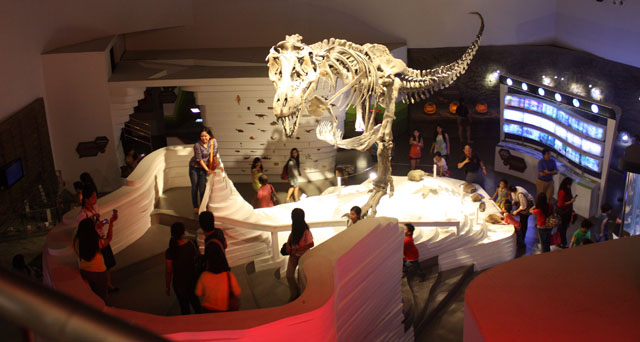 “Hindi problem ng mga bata na ayaw nila ng science. It's the lack of mentors. Walang mentors e. Walang tao na nandun sa lab so it becomes a vicious cycle. Kung walang mentors, paano ka magpoproduce ng next generation of scientists?” said UP Diliman Chancellor Caesar Saloma, who is also one of f Asia's top scientists according to Asian Scientist Magazine.
“Hindi problem ng mga bata na ayaw nila ng science. It's the lack of mentors. Walang mentors e. Walang tao na nandun sa lab so it becomes a vicious cycle. Kung walang mentors, paano ka magpoproduce ng next generation of scientists?” said UP Diliman Chancellor Caesar Saloma, who is also one of f Asia's top scientists according to Asian Scientist Magazine. Soriano agreed with what the chancellor said: “Kulang ng qualified teacher to explain the course very well.”
In Science Education Institute of the DOST survey in 2009, out of the (then) almost 1,500 higher education institutions in the country, only seven have established programs in the basic and applied sciences.
These seven institutions now comprise the National Science Consortium. The seven institutions are UP, Ateneo de Manila University, De La Salle University, University of Santo Tomas, Central Luzon State University, Visayas State University and Mindanao State University-Iligan Institute of Technology. The consortium was established to keep up with the demand for scientific researchers and scientists. It gives a number of scholarships for graduate and post graduate applicants to pursue their researches. However, the consortium only started implementing its program last year and results have yet to be seen.
Budget still lacking
The Philippine government, for its part, has yet to put science and technology among its first priorities.
The Department of Education (DepEd) received the largest budget in the 2012 General Appropriations Act at P238.8 billion while the Department of Science and Technology (DOST) received roughly over P2 billion (See graph below). 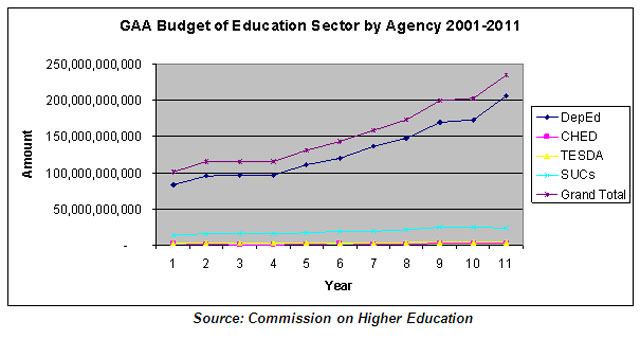

Licuanan said, “The government has already invested in education but we need more.”
“Ang kailangan talaga, yung State yung nangunguna diyan. Kaysa sa mga chalk-and-talk na mga kurso kasi iyon yung mura,” said Sen. Edgardo Angara in an earlier interview with GMA News. He is also the chairperson of the Senate Committees on Education, and Science and Technology.
Science and technology has long been correlated to the country’s per capita income.
“Hindi naman cause and effect.... they are correlated. It is always safe bet that we invest in our scientific enterprise system because mahirap matalo in terms of their contribution when it comes to economic growth,” Saloma said. Aiming for the Nobel Prize
“Makikita natin sa 90 percent ng nanalo ng Nobel Prize sa basic sciences ay resulta sa mga trabahong ginagawa sa mga university research centers. Ito ang relationship ng universities at scientific research. Scientific research produces scientific knowledge. Scientific knowledge fuels technological innovation, and in a sense entrepreneurship,” Saloma added.
“We definitely need more scientists. But more than the scientists, I think we need more scientific thinking. People who really consistent in their way of thinking, and who are evidence-based when you have decisions, when you have judgments,” said Garrick Bercero. He graduated with a bachelor’s degree in Molecular Biology and Biotechnology at the University of the Philippines. — TJD, GMA News
More Videos
Most Popular



